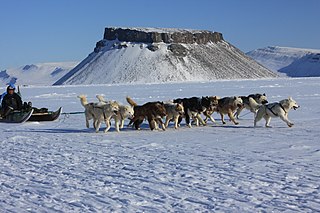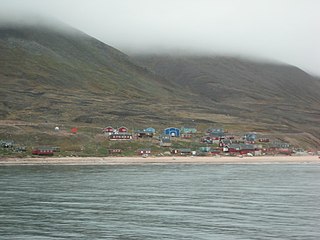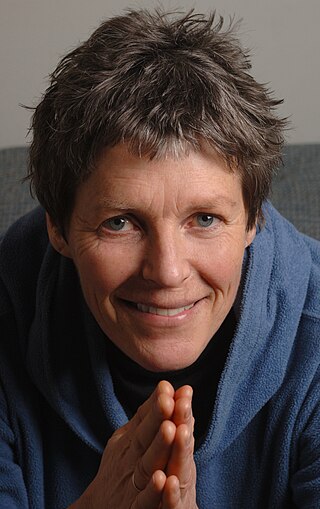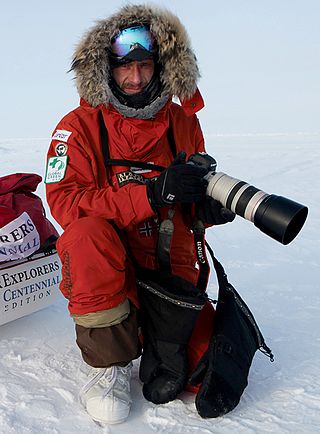
Knud Johan Victor Rasmussen was a Greenlandic–Danish polar explorer and anthropologist. He has been called the "father of Eskimology" and was the first European to cross the Northwest Passage via dog sled. He remains well known in Greenland, Denmark and among Canadian Inuit.

Robert Edwin Peary Sr. was an American explorer and officer in the United States Navy who made several expeditions to the Arctic in the late 19th and early 20th centuries. He is best known for, in April 1909, leading an expedition that claimed to be the first to have reached the geographic North Pole.

Ellesmere Island is Canada's northernmost and third largest island, and the tenth largest in the world. It comprises an area of 196,236 km2 (75,767 sq mi), slightly smaller than Great Britain, and the total length of the island is 830 km (520 mi).

Qaanaaq, formerly known as Thule or New Thule, is the main town in the northern part of the Avannaata municipality in northwestern Greenland. It is one of the northernmost towns in the world. The inhabitants of Qaanaaq speak the local Inuktun language and many also speak Kalaallisut and Danish. The town has a population of 646 as of 2020. The population was forcibly relocated from its former, traditional home, which was expropriated for the construction of a United States Air Force base in 1953.

Pituffik is a former settlement in northern Greenland, located at the eastern end of Bylot Sound by a tombolo known as Uummannaq, near the current site of the American Pituffik Space Base, formerly Thule Air Base. The former inhabitants were relocated to the present-day town of Qaanaaq. The relocation and the fallout from the 1968 Thule Air Base B-52 crash in the vicinity are a contentious issue in Greenland's relations with Denmark and the United States.

Siorapaluk or Hiurapaluk is a settlement in the Qaanaaq area of the Avannaata municipality in northern Greenland. It is one of the world's northernmost inhabited settlements, the northernmost settlement inhabited by natives, and the northernmost public settlement in Greenland. It has a population of 43 who speak the Inuktun language of the Polar Inuit as well as the Kalaallisut dialect of Greenlandic. Many of the inhabitants are direct descendants of the last migration of Inuit from Canada in the 20th century.

Liv Ragnheim Arnesen is a Norwegian educator, cross-country skier, adventurer, guide, and motivational speaker. Arnesen led the first unsupported women’s crossing of the Greenland Ice Cap in 1992. In 1994, she made international headlines becoming the first woman in the world to ski solo and unsupported to the South pole. – a 50-day expedition of 745 miles (1,200 km).

The Inughuit, or the Smith Sound Inuit, historically Arctic Highlanders or Polar Eskimos, are Greenlandic Inuit. They are the northernmost group of Inuit and the northernmost people in North America, living in Greenland. Inughuit make up about 1% of the population of Greenland.
Comer's Midden was a 1916 archaeological excavation site near Thule, north of Mt. Dundas in North Star Bay in northern Greenland. It is the find after which the Thule culture was named. The site was first excavated in 1916 by whaling Captain George Comer, ice master of the Crocker Land Expedition's relief team, and of members of Knud Rasmussen's Second Danish Thule Expedition who were in the area charting the North Greenland coast.
Eric Philips OAM is an Australian polar explorer, adventurer and polar guide.
Count Eigil Knuth was a Danish explorer, archaeologist, sculptor and writer. He is referred to as the Nestor of Danish polar explorers. His archaeological investigations were made in Peary Land and adjacent areas of High Arctic Greenland. Knuth was made a Knight of the Dannebrog.
David Haig-Thomas was a British ornithologist, wildlife photographer, explorer and rower who competed for Great Britain in the 1932 Summer Olympics. He was an army commando during the Second World War, and was killed in action during the Normandy Landings. Haig-Thomas Island in the Canadian Arctic is named after him.
Augustine Courtauld, often called August Courtauld, was a yachtsman and British Arctic explorer, best known for serving as the solo meteorologist of a winter observation post, Icecap Station, located in the interior of Greenland in 1930–1931.

Sebastian Copeland is a British-American-French photographer, polar explorer, author, lecturer, and environmental advocate. He has led numerous expeditions in the polar regions to photograph and film endangered environments. In 2017, Copeland was named one of the world's top 25 adventurers of the last 25 years by Men's Journal. He is a fellow of The Explorers Club. His documentary Into the Cold was a featured selection at the 2010 Tribeca Film Festival and was released on DVD timed to Earth Day 2011.
Adrian Hayes is a British record-breaking polar explorer and adventurer, best known for reaching the three extreme points of the Earth—the Three Poles Challenge—which involved walking all the way to the North Pole, South Pole and summiting Mount Everest, all in the shortest period of time.
John Huston is an American polar explorer, motivational speaker, wilderness guide, and safety and logistics consultant. In 2009, Huston completed the first successful unsupported American expedition to the North Pole. He has also completed expeditions to the South Pole, Greenland, and Ellesmere Island. Huston is the co-author of Forward: The First American Unsupported Expedition to the North Pole.

Ramón Hernando de Larramendi is a Spanish polar explorer and adventurous traveler who has promoted and developed a WindSled unique in the world, intended for the research in Antarctica and Greenland. He has travelled more than 40,000 km in polar territories.
Jade Hameister is an Australian woman who, at age 16, became the youngest person in history to pull off the "polar hat-trick", ski to the North and South Poles, and cross the second largest polar icecap on the planet: Greenland. Hameister travelled over 1,300 km on these three missions, which totalled almost four months on ice.












